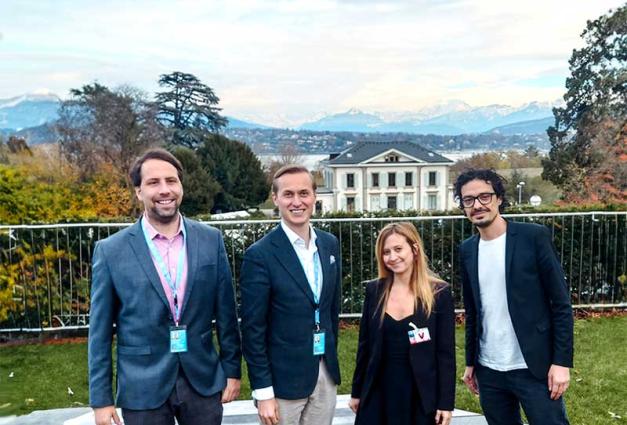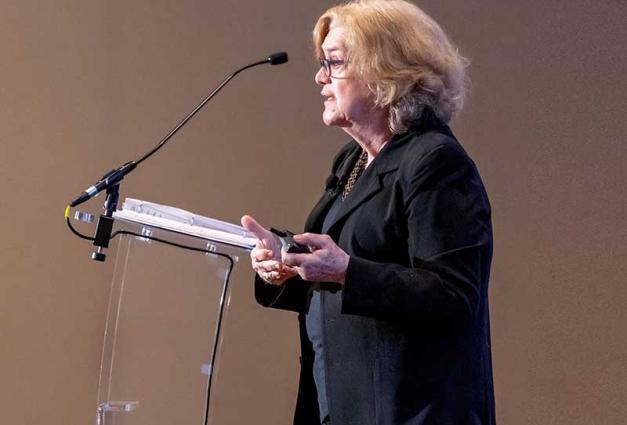In what may become a yearly tradition here at the SPSPotlight newsletter, we are recapping the Presidential Plenary from the just-completed 2023 Annual Convention in this piece.
This year's plenary session focused on a theme that is central to much of the work we do as social and personality psychologists—norms, and how they change. Social norms—what others do, and want or expect us to do, have an impact on our own beliefs, feelings, and behaviors, and influence the world we create for ourselves. As we consider the ways in which social and personality psychology research can help address the issues of our generation—be it poverty, injustice, or conflict, or even improving individual health behaviors—much of this is dependent on understanding normative behavior and employing the power of norms to change behaviors in ways that are sustainable. Four scholars presented their work on norm change—Catherine Thomas, Colin Wayne Leach, Guy Elcheroth, and Christina Bicchieri. In this piece, we're focusing on the first two talks on poverty alleviation and understanding the complex dynamics of protest behaviors.
Watch the 2023 SPSP Presidential Plenary
Culturally Wise Interventions Can Help Reduce Extreme Poverty in West Africa
Catherine Thomas, Stanford University
As we think about how behavioral science can be used to address global problems, accounting for social norms is an important part of the puzzle. Social norms differ from place to place depending on cultural context, and tailoring interventions to norms can be beneficial to program success and sustainability. In an interdisciplinary partnership with the government of Niger, the World Bank, economists, and psychologists, Dr. Thomas and colleagues examined how "culturally wise" messaging could alleviate hunger by promoting women's entrepreneurship. To set the context, Niger is among the lowest-income countries owing to historical inequities. The nation is also at the frontline of climate change, due to its location at the edge of the Sahara Desert. The goal of this research program was to develop an evidence-based program to alleviate poverty and hunger, with the goal to promote women's entrepreneurship among women experiencing extreme hunger, and provide an alternative to subsistence farming. However, entrepreneurship can be seen as an unacceptable activity for women in a context with more rigid gender roles and an interdependent cultural context.
A "culturally-wise" intervention is one that eases barriers to change by attending to questions and concerns about a new behavior or opportunity, and offers a construal that aligns with culturally normative values and beliefs. In this case, they needed to design an intervention that promoted women's entrepreneurship as actively advancing interdependent values of respect and social harmony. Communities were randomly assigned to a control condition, where they received economic training (e.g. savings program) or three treatment conditions, all of which had components in addition to the base economic training in the control. The first treatment condition included an unconditional cash transfer of $300, the second included a culturally wise psychosocial intervention, and the third condition had all three together—economic training, cash transfer, and psychosocial intervention. Follow-ups were done one and two years after the initial intervention. The culturally wise psychosocial condition was comprised of a community film event and life skills training, both tailored to specific existing cultural norms. The final message of the film conveyed that entrepreneurship not only enriched the women entrepreneurs, but also helped them be useful to their families and village. After the screening, participants had a group discussion on how women's entrepreneurship could contribute to community values and goals, such as generosity and respect. The life skills training addressed goal setting, effective communication, and problem-solving in ways that were tied to interdependent values.
Did these interventions work? In short, yes. They found that women's entrepreneurship increased in all three treatment conditions compared to the control. With respect to poverty alleviation, comparing against a benchmark of extreme poverty as earnings of $1.90/day, the cash transfer group had greater economic gains compared to control, but was still below the benchmark. However, the psychosocial treatment group brought them up to exactly $1.90/day, and the third treatment group with both cash transfer and psychosocial training crossed the benchmark with earnings of $1.95/day. In terms of benefit to cost ratio of the different packages, the psychosocial package improved both economic gains and food security, while keeping costs low and producing a benefit three times the cost of implementation (among the largest benefit-to-cost ratio in this literature). Discussions during the follow-ups suggested that the success of the psychosocial intervention was driven partly by the interdependent (vs independent) construal framing of women's entrepreneurship and socially relevant exercises participants completed during the life skills training.
This work provides large-scale evidence from real-world data that culturally wise interventions are not only viable, but also necessary to solve social issues. With a scientific literature comprised largely of Western, high-income samples, our science may be culturally wise only to these contexts, and we may be missing out on key motivations forces like peace and respect.
The Dynamics of Sentiment Toward Racial Justice Protest in the United States
Colin Wayne Leach, Columbia University
Protest can be seen as normative or as the right thing to do, but sometimes, in situations where protests become violent, even violent protest can become normative locally in small areas or within particular groups. Dr. Leach and colleagues have developed the dynamic dual pathway that takes a systems perspective to explain protest motivations and the different norms that are created within groups in a localized manner. They argue that people come to define injustice as it relates to group-level identities, and within that collective, they may define various protest behaviors as appropriate for them (including civil disobedience, property violence, etc.), and this can then become normative within the bounds of that group. Social support plays an important role here in reinforcing cognitions and emotions surrounding injustice and protest, especially in the case of low-status and disadvantaged groups.
In exploring the nuances of how norms around protest behaviors are formed, we must first understand how the literature has defined normative and non-normative protest. Most psychological literature defines normative protest as what is perceived as legitimate protest, i.e. an injunctive norm—the majoritarian norm that peaceful and non-violent protest is seen as the only legitimate protest. While such a majoritarian view can establish a norm, the dual pathway model employs a systems view, allowing for multiple groups to have varying ideas of legitimate protest, including a violent protest. These group norms may be loosely tied to or even opposite to the societal norm of non-violent protest. Such a view—a system-of-systems view—is more consistent with the ideological and political differences in ideas around protest in society.
Dr. Leach and colleagues developed and tested the dual pathway model using small-scale experiments, and big-data analysis of news and social media. The latter affords rich data to examine the complex dynamics of protest in a way that reflects real-world sentiment. In an ongoing project examining sentiment around racial injustice through social media, the research team followed Twitter activity for three weeks following the killing of Michael Brown, with tweets including any mention of 40 different terms related to the killing. Their final sample comprised of 12.5 million tweets from 1.7 million users. Dominant themes that emerged in unique tweets included police racism and communal justice. When examining content sentiment, they found that those tweeting about communal justice were the only ones who had positive semantic content compared to those tweeting about police racism, the funeral, or officer shooting. When examining tweet content using Linguistic Inquiry and Word Count (LIWC), models revealed that anger rose dramatically towards the end of the three-week period, consistent with the dual pathway model (and others) where anger predicts protest. Consistent with the dual pathway's view of a sense of collective efficacy predicting protest, content with references to power, strength, and affiliation also increased at the end of the period. Examinations of this kind of large-scale data allow researchers to examine the heterogeneity of people's cognition and affect, along with both broader societal norms and localized, group-defined norms that influence them.
We thank Drs. Thomas and Leach for sharing their findings and insights with convention attendees. Stay tuned for our next SPSPotlight feature, publishing on April 20, which will include a recap of the presentations that Drs. Elcheroth and Bicchieri delivered during the Presidential Plenary!




